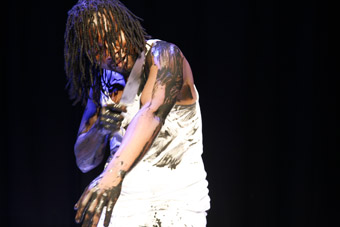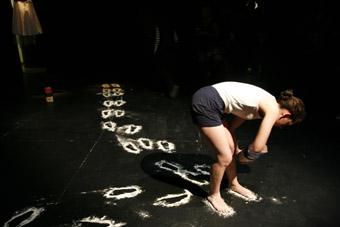of tea and other fluids
marie-anne mancio, east end collaborations, london

Alexander C Bede, SCRUB
photo Christa Holka
Alexander C Bede, SCRUB
EAST END COLLABORATIONS—A PARTNERSHIP BETWEEN QUEEN MARY, UNIVERSITY OF LONDON AND THE LIVE ART DEVELOPMENT AGENCY—CELEBRATES ITS 10TH ANNIVERSARY THIS YEAR. THE OCCASION WAS MARKED BY A LIVE ART WEEKEND AT QMUL INTRODUCED BY SUSANNAH HEWLETT’S ‘JINGLE’, “PROUD TO BE PRESENTING”, AND HOSTED BY THE INDEFATIGABLE TAMMY WHYNOT (LOIS WEAVER) IN FEATHER BOA AND PLATINUM WIG.
Day one features artists who performed at previous EEC platforms and is their opportunity to reflect on subsequent development. A common refrain is how making work is contingent on myriad factors—money, space, mood, context, opportunity…I like the simplicity and honesty of Sheila Ghelani’s video Grafting and Budding…still, about the process of revising a piece for different contexts. Composed of close-up shots of a hand resting on a diary page, interspersed with stills, it trips along to Colin James’ catchy “Five Long Years”, also acting as effective documentation of the original performance—apple halves skewered and clipped together, placed in Barnett Newman-like zip markings of blood and spice.
Conversely Emma Wolukau-Wanambwa’s Documentation of Cooper House—no doubt a beautiful work as a mixed-media installation—suffers from the absence of the artist and/or lack of contextualisation. Richard DeDominici contributes Plagiarismo! Redux, a comic, accessible slide-lecture on plagiarism (“Which came first: the swan or the police van?”). More conceptually sophisticated though are Angela Bartram’s Untitled, a lecture on her work (Spit and Lick; Licking Dogs) and Oreet Ashery’s video installation Back in Five Minutes. Bartram’s footage of herself and various dogs engaged in mouth-to-mouth licking is underpinned by a theoretical enquiry around notions of abjection and the anti-social mouth and succeeds in making viewers very uncomfortable; whilst Ashery explores disappearance and otherness.
The second day includes discussions, advice sessions (Everything You Wanted To Know About Live Art But Were Afraid To Ask) and this year’s platformers. The range is impressive: from work openly dealing with ‘issues’ to the sensory seduction of Poppy Jackson’s Untitled where, amid birdsong, smells of melting wax and poster paint, a woman with red bunting wrapped round her wrists balances on a birthday cake in the yellowy light of a summer’s day. Incarceration—Lisa Wright’s caged girl-as-mannequin lit by strobe lights—also stuns. Sian Robinson-Davies’ Disguised as Things is a witty, economical work about becoming inanimate in the context of liveness. At its start we’re handed plastic flowers to throw at the stage when performers take their bow. Format: a man reads the sign he holds (“the lamp”) and a woman becomes it (wearing a shade on her head, trailing a flex, reading a newspaper). This continues: “the jacket”; “birdie”; “the mirror”; “the apple tree”. The last is “the vase” in which both performers drink water then bow….Still life that won’t stay still or a lecture in semiotics?
In a Britain with newly-elected, neo-fascist Euro MPs, Alexander C Bede’s dissection of race, SCRUB, feels especially pertinent. There is a black coffin filled with what looks like white tissue and a table laid out with a selection of cleaning implements: sponges, towels, wire wool, a knife, bleach. Black and white grow more sinister: the white-suited, lone black performer, his bare arms coated in black paint, scrubs away to make himself lighter. When he asks us to pass him something, no-one wants to move, unwilling to be complicit in this bleaching game. The spoken text (about the need to be whiter for better prospects) is redundant: the smell of bleach suffusing the room and Bede’s reddening skin are powerful enough.

Rachel Mars, Unto Us A Child Is Born
photo Christa Holka
Rachel Mars, Unto Us A Child Is Born
Rachel Mars’ unashamedly feminist Unto Us A Child Is Born also impresses. Entering the space, I’m asked “Luke Skywalker or Princess Leia?” As Skywalker, I receive a packet of self-raising (rather than plain) flour labelled “Grip me.” Mars asks if anyone has ballet dancers in the family; muses on the difficulty of reconciling a desire for femininity with self-identification as a tomboy; longs for weightlessness without the need to be lifted. The text shifts: conversational, funny, confessional, statistical, self-deprecating, quasi-poetic (she calls Baby in Dirty Dancing a “befrocked snowstorm of soft focus”) till she is climbing a rope ladder in high heels and a netted white dress. “If you could just lift your own weight”, she says, hanging impressively from a bar in the rafters. “It’s very close to theatre”, someone mutters (an accusation levelled at Rose English years ago, so Mars is in good company).
Another performer to look out for is Martin O’Brien. Unlike Ben Connors & Holly Darton’s Couple or Jungmin Song’s A Reel to A Reel which test audience endurance, O’Brien’s durational work Repetitive Strain Syndrome is utterly compelling. Legs taped together, he stumbles on gold lamé heels across a floor littered with a plunger and bits of coal-like faeces whilst a zealous dominatrix in a gimp mask sets tasks and abuses him. When she hands me a wooden pole, I nudge his waist. Another viewer is more vigorous, appears to have discovered his sadistic streak. Occasionally, a musician twangs an electric guitar or O’Brien stops to describe a gruesome punishment—the scold’s bridle, the stocks. Sex game or act of torture, it’s a real tour de force.
In an inspired installation, Lindsey Price and Francesca Millican-Slater’s Ed Venture’s Quintessentially English Tea Room honours the nation’s legendary attachment to tea. I am seated with strangers, my order taken by a uniformed waitress. Place mats encourage writing on the tablecloths, suggesting “the weather” and “tea stories” as suitable topics of conversation; I unwrap a personal message: “first love.” Sipping loose-leaf Earl Grey from patterned china and indulging in cup cakes, we talk about the performances we’ve seen so far. An opportunity to network in a relaxed way, the tearoom is a joyous antidote to the homogenous chain café. One of my tea companions wonders whether this piece is symptomatic of a recession-friendly genre of performance where the viewer-participant is treated more gently. Quite possibly. For me it sums up East End Collaborations: a site of nurture and debate from which I, like live art, emerge re-energised.
Queen Mary University of London and the Live Art Development Agency, East End Collaborations 2009—Tenth Anniversary Platform; Queen Mary University of London June 5, 6, www.thisisliveart.co.uk
RealTime issue #92 Aug-Sept 2009 pg. 10






